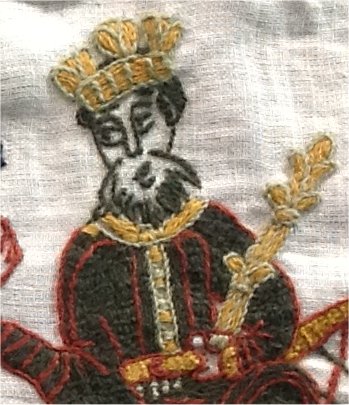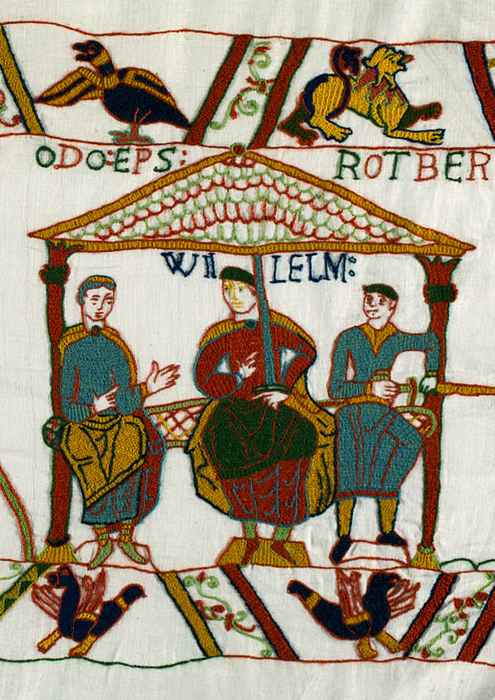The 49 Scenes from the Bayeux Tapestry.

Main characters in The Bayeux Tapestry
| King Edward: | (Edward the Confessor), born 1003, ruled England in the years 1042-1066 |
| Duke Wilhelm: | (Wilhelm the conqueror) born 1027, won the battle of Hastings in 1066. Ruled England 1066-1087. |
| Harold Godwinson: | 1022-1066, Earl of Wessex, was crowned king of England in 1066 after the Death of Edward, but fell in the battle of Hastings in October 1066. |
| Bishop Odo of Bayeux: | half-brother to Wilhelm, 1032-1097. Considered the main initiator of the makings of the Bayeux tapestry. |
The Bayeux Tapestry shows 49 scenes of history about the battle of Hastings in 1066 and a chronicle of events prior to the invasion. The scenes are in most cases framed by stylized trees or towers.
The Bayeux Tapestry shows 49 scenes of history about the battle of Hastings in 1066 and a chronicle of events prior to the invasion. The scenes are in most cases framed by stylized trees or towers.
Scene 1: The tale begins around 1064, where Harold Godwinson by King Edward is ordered to travel to Normandy, where he officially shall confirm the promise that Wilhelm years ago received about inheriting the English throne after the death of Edward. Harold and his entourage ride for Bosham to Harold farm.
Scene 2: During the journey they visit Harold Bosham’s church and probably pray for a prosperous journey. Parts of Bosham’s church still stands to this say. Harold and his men eat at Harold’s farm before they start the journey. They board the ship taking hunting falcons and dogs with them. The five ships are presumably showing the same ship on different stages of the journey. Harold himself is steering. They throw anchor at the mouth of the river Somme. For some reason they have gone off course and when they go ashore, they are captured by Wilhelm’s vassal the count Guy and his armed following.
Scene 3: Harold and his men are taken to Count Guy’s castle. Harold rides at the front with his falcon in his hand. Right behind him is Guy, also with a falcon. Behind Guy rides two Englishmen (recognizable by the mustache) and three Normans (Clean-shaved Nape) Inside the castle is Guy (In the high seat) in conversation with Harold (standing). One of Guy’s men is pointing at a person listening in on the conversation. Maybe this is the person that carries the message of Harold’s capture to Wilhelm.
Scene 4+5: The next scene must be ’read backwards’. Wilhelm receives the message about Harold’s capture: The messager could be one of Harold’s men who has managed to escape from Guy. Two of Wilhelm’s messengers ride off with great urgency. They arrive and meet count Guy who is dressed very neatly and is leaning on his Danish battle-axe. Turold is the name either of the dwarf or one of the messengers.
Wilhelm’s messengers demand both Harold and his men released. Guy takes Harold to Wilhelm who has ridden out to meet them. An armed escort accompanies both.
Scene 6: Wilhelm leads Harold to his castle in Rouen.
Scene 7: Wilhelm is sitting in the high seat and Harold is speaking with many gestures. Maybe he is explaining his errand to Wilhelm. One of his men stand behind him. Three Normans with four shields stand far to the right.
No one today knows the significance of the scene that takes place outside the castle. Presumably, it was known at the point of the tapestry’s creation. Many books have been written, trying to interpret this scene of Ælfgyva and ‘a certain clerk’. Ælfgyva is one of the only three women depicted in the entire tapestry.
Scene 8: Harold is now staying with Wilhelm in Normandy. Wilhelm allows Harold to take part in the campaign he launches against Conan of Bretagne. The Mont Saint-Michel Monastery is located at the mouth of the river between Bretange and Normandy. It is an area with dangerous quicksand. Harold saves some of Wilhelm’s men from the quicksand.
Scene 9: The Normans attack Dol Bretagne and Conan flees the fortress.
Scene 10: Conan has fled to Dinan where he is attack by Wilhelm and his men set the fortress aflame. Conan surrenders and, from the tip of his lance, hands over the keys to the city.
Scene 11: Harold is given full warfare equipment, breastplate, helmet, sword and lance as a show of gratitude. However, that also means that Harold now is bound to serve Wilhelm.
Scene 12: Wilhelm and Harold return to Bayeux
Scene 13: Harold swears fealty. Wilhelm sits in the high seat. Harold swears his oath between two shrines.
Scene 14. Harold sails home to England and rides for London.
Scene 15: Harold get an audience with King Edward who sits sickly and weak on his throne. Harold’s guilty conscience is plain as day as he delivers his report.
Scene 16 + 17: Another few scenes that has to be ’read backwards’. On the top is depicted the dying king surrounded by mourners including queen Edith whom is Harold’s sister. Edward died the 5th of January 1066.
At the bottom is King Edward being prepared for his funeral. On the left, King Edward is carried to his grave in the apostle Saint Peter’s Church.
The same church that would later be known as Westminster Abbey.
At the far left is depicted the church that has just been completed and consecrated the 28th of December 1066. The hand of God confirms the consecration that the old king had been to sickly to partake in.
Scene 18: Harold is offered the crown by two men. He accepts despite his vows of fealty to Wilhelm. Harold is crowned king under the name Harold the second.
Scene 19: Harold sits on his throne with crown, scepter and orb while he is being hailed by the people.
Scene 20: A group of people have caught sight of a luminous celestial body that moves over London.
Scene 21: The King is very startled by the phenomenon and almost falls off his throne. The Depicted Celestial body is Halley’s comet, first described by the Chinese in 466 BC. Its orbital period is around 76 years. Last visible in 1985/86.
Scene 22: An English ship arrives in Normandy.
Scene 23: The News of Harold’s coronation reaches Wilhelm. Wilhelm sits in the middle, at his right is his half-brother bishop Odo. He is recognizable by his tonsure
Scene 24: Wilhelm decides to build a fleet. He intends to invade England and claim the English throne. On the tapestry is depicted how trees are cut down, debarked and manufactured into planks. The construction of the ships is depicted right after. Pay extra attention to the different tools.
Scene 25: The ships are pulled ashore and moored.
Scene 26: Supplies a brought on board: chain mail, weapons, helmets, axes and spears. Sacks of wine, barrels of wine and a wagon carrying a great wine-cask. They are French!
Scene 27: Wilhelm rides to the beach with his men to come on board the ship.
Scene 28: 12th of August. The fleet is ready, but the departure is delayed because the wind is not in their favor. Wilhelm’s fleet finally reaches England the 28th of September 1066.
Scene 29: The horses are taken ashore and the men rides to Hastings for provisions.
Scene 30: Only very few people on the tapestry are mentioned by name. This is one of them. Waddard. It is not known who or what he was. Maybe the master of provisions?
Scene 31: Soup is boiled, there is meat on a spit ready to be roasted, and bread is baked.
Scene 32: Two assistants hand the food over to two men at a table – and the man with the horn calls to dinner.
Scene 33: The meal is held at a semicircular table. The waiter beneath the table has wine and a towel ready for the mandatory hand washing. Odo sits at the table and blesses the food. Duke Wilhelm and the others concentrate on eating and drinking.
Scene 34: Wilhelm holds a meeting with his half-brothers Odo and Robert after the meal
Scene 35: Wilhelm’s men build a fortress in Hastings with palisades and guard towers.
Scene 36: Wilhelm is informed that King Harold and his armies are in motion. Wilhelm holds the banner the pope has sent him. A Banner that means he acknowledges Wilhelm’s invasion as a crusade to England.
Scene 37:Two men set a house on fire and a noble lady and a child flees the scene.
Scene 38:Preparations for battle. Wilhelm is depicted wearing a chest plate and a helmet and has a sword at his side. One of his men brings out his Spanish stallion. The riders leave Hastings to fight against King Harold. Wilhelm rides at the front.
Scene 39: Another man is mentioned by name: Vital. He was sent out to scout and tells in this scene Wilhelm where Harold’s army is. A patrol has reached a hilltop where they can observe the enemy’s outpost.
Scene 40: From a hilltop on the other side of the trees and Englishman is looking for the Normans. Another Englishman tells King Harold that the Normans are approaching. Harold’s horse is the only English horse depicted on the tapestry.
Scene 41: Wilhelm is rallying his troops for battle. Archers stand in front of the riders.
Scene 42: Harold’s army form a shield wall against the Normans
Scene 43-44: The English footmen fight the Norman riders
Scene 45: King Harold’s two brothers Leofwin and Gyrd fall in battle
Scene 46: The tapestry depicts realistically the bloody battles that claims many lives on both sides.
Scene 47: A rumor arose at some point that Wilhelm had fallen. But Wilhelm pushed his helmet back so everyone could see him and yelled. ” I am Alive!”
Scene 48: King Harold is killed – an as a result the battle that has lasted for 8 hours comes to an end.
Scene 49: The English flee.
The end of the tapestry has been lost. Presumably, it has depicted Wilhelm’s coronation, which was held on Christmas day 1066 in the apostle Skt. Peters church. The later Westminster Abbey.
The following is 8 scenes from our proposal of an ending.
|
Scene 1 The gray apple tree (Battlefield of Hastings.) Scene 2 The ride to Dover. Scene 3 The Dover Castle. Scene 4 Presentation and compensation. Scene 5 The ride to London. Scene 6 The Apostle St. Peter’s Church(later Westminster Abbey.) Scene 7 The Crowning. Scene 8 The laterallly reveversed Arkantus Runner. |

www. bayeuxtapetet.dk – The Bayeuxgroup – Copyright 2012 ©


